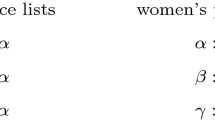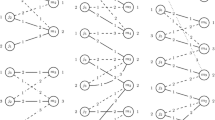Abstract
A new interpretation of the stable marriage problem posed by Gale and Shapley is presented. This approach enables one to solve efficiently this version of the assignment problem when it is known that the preference information is inaccurate or when there is a need to reduce the computational requirements of the problem. Savings on the order of 30% for CPU time have been demonstrated in test cases.
Similar content being viewed by others
References
D. Gale and L. S. Shapley,College admissions and the stability of marriage, Am. Math. Monthly, 69 (1962), 9–15.
S. Itoga,The upper bound for the stable marriage problem, J. Opl. Res. Soc., 29 (1978), 811–814.
S. Itoga,A generalization of the stable marriage problem, J. Opl. Res. Soc., 32 (1981), 1069–1074.
D. G. McVitie and L. B. Wilson,The application of the stable marriage assignment to university admissions, Opl. Res. Q., 21 (1970), 425–433.
D. G. McVitie and L. B. Wilson,Stable marriage assignment for unequal sets, BIT 10 (1970), 295–309.
D. G. McVitie and L. B. Wilson,The stable marriage problem, Comm. ACM 14 (1971), 486–490.
L. G. Proll,A simple method of assigning projects to students, Opl. Res. Q. 23 (1972), 195–201.
L. B. Wilson,An analysis of the stable marriage assignment problem, BIT 12 (1972), 569–575.
Author information
Authors and Affiliations
Additional information
This work was supported by the U.S. Army Research Office.
Rights and permissions
About this article
Cite this article
Itoga, S.Y. A probabilistic version of the stable marriage problem. BIT 23, 161–169 (1983). https://doi.org/10.1007/BF02218437
Received:
Revised:
Issue Date:
DOI: https://doi.org/10.1007/BF02218437




